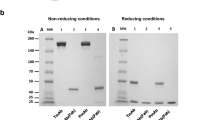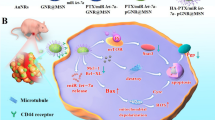Abstract
This aim of this study was to develop peptide-conjugated nanoparticles (NPs) for systemic co-delivery of siRNA and doxorubicin to enhance chemotherapy in epidermal growth factor receptor (EGFR) high-expressed ovarian tumor bearing mice. The active targeting NPs were prepared using heptapeptide-conjugated poly(d,l-lactic-co-glycolic acid)–poly(ethylene glycol). The particle sizes of peptide-free and peptide-conjugated NPs were 159.3 ± 32.5 and 184.0 ± 52.9 nm, respectively, with zeta potential −21.3 ± 3.8 and −15.3 ± 2.8 mV. The peptide-conjugated NPs uptake were more efficient in EGFR high-expressed SKOV3 cells than in EGFR low-expressed HepG2 cells due to heptapeptide specificity. The NPs were used to deliver small molecule anticancer drug (e.g., doxorubicin) and large molecule genetic agent (e.g., siRNA). The IC50 of doxorubicin-loaded peptide-conjugated NPs (0.09 ± 0.06 μM) was significantly lower than peptide-free NPs (5.72 ± 2.64 μM). The similar result was observed in siRNA-loaded NPs. The peptide-conjugated NPs not only served as a nanocarrier to efficiently deliver doxorubicin and siRNA to EGFR high-expressed ovarian cancer cells but also increased the intracellular accumulation of the therapeutic agents to induce assured anti-tumor growth effect in vivo.









Similar content being viewed by others
References
Beletsi A, Panagi Z, Avgoustakis K (2005) Biodistribution properties of nanoparticles based on mixtures of PLGA with PLGA–PEG diblock copolymers. Int J Pharm 298:233–241
Burnett JC, Rossi JJ (2012) RNA-based therapeutics: current progress and future prospects. Chem Biol 19:60–71
Burnett JC, Rossi JJ, Tiemann K (2011) Current progress of siRNA/shRNA therapeutics in clinical trials. Biotechnol J 6:1130–1146
Chen Y, Bathula SR, Li J, Huang L (2010) Multifunctional nanoparticles delivering small interfering RNA and doxorubicin overcome drug resistance in cancer. J Biol Chem 285:22639–22650
Chittasupho C, Xie SX, Baoum A, Yakovleva T, Siahaan TJ, Berkland CJ (2009) ICAM-1 targeting of doxorubicin-loaded PLGA nanoparticles to lung epithelial cells. Eur J Pharm Sci 37:141–150
Choi SK, Verma M, Silpe J, Moody RE, Tang K, Hanson JJ, Baker JR Jr (2012) A photochemical approach for controlled drug release in targeted drug delivery. Bioorg Med Chem 20:1281–1290
Couvreur P, Vauthier C (2006) Nanotechnology: intelligent design to treat complex disease. Pharm Res 23:1417–1450
Filmus J, Pollak MN, Cailleau R, Buick RN (1985) MDA-468, a human breast cancer cell line with a high number of epidermal growth factor (EGF) receptors, has an amplified EGF receptor gene and is growth inhibited by EGF. Biochem Biophys Res Commun 128:898–905
Gilabert-Estelles J, Braza-Boils A, Ramon LA, Zorio E, Medina P, Espana F, Estelles A (2012) Role of microRNAs in gynecological pathology. Curr Med Chem 19:2406–2413
Gillies ER, Frechet JM (2005) pH-Responsive copolymer assemblies for controlled release of doxorubicin. Bioconjug Chem 16:361–368
Guo AVSJ, Jozsef Varga MZ, Leung PCK (2010) Antiproliferative effect of growth hormone-releasing hormone (GHRH) antagonist on ovarian cancer cells through the EGFR-Akt pathway. Reprod Biol Endocrinol 8:11
Hillaireau H, Couvreur P (2009) Nanocarriers’ entry into the cell: relevance to drug delivery. Cell Mol Life Sci 66:2873–2896
Huang M, Ma Z, Khor E, Lim LY (2002) Uptake of FITC-chitosan nanoparticles by A549. Pharm Res 19:1488–1494
Itabashi H, Maesawa C, Oikawa H, Kotani K, Sakurai E, Kato K, Komatsu H, Nitta H, Kawamura H, Wakabayashi G, Masuda T (2008) Angiotensin II and epidermal growth factor receptor cross-talk mediated by a disintegrin and metalloprotease accelerates tumor cell proliferation of hepatocellular carcinoma cell lines. Hepatol Res 38:601–613
Kamaly N, Xiao Z, Valencia PM, Radovic-Moreno AF, Farokhzad OC (2012) Targeted polymeric therapeutic nanoparticles: design, development and clinical translation. Chem Soc Rev 41:2971–3010
Khoee S, Rahmatolahzadeh R (2012) Synthesis and characterization of pH-responsive and folated nanoparticles based on self-assembled brush-like PLGA/PEG/AEMA copolymer with targeted cancer therapy properties: a comprehensive kinetic study. Eur J Med Chem 50:416–427
Kneidinger D, Ibrisimovic M, Lion T, Klein R (2012) Inhibition of adenovirus multiplication by short interfering RNAs directly or indirectly targeting the viral DNA replication machinery. Antiviral Res 94:195–207
Kundu AK, Chandra PK, Hazari S, Pramar YV, Dash S, Mandal TK (2012) Development and optimization of nanosomal formulations for siRNA delivery to the liver. Eur J Pharm Biopharm 80:257–267
Lamy PJ, Jacot W (2012) Worldwide variations in EGFR somatic mutations: a challenge for personalized medicine. Diagn Pathol 7:13
Lehtinen J, Raki M, Bergstrom KA, Uutela P, Lehtinen K, Hiltunen A, Pikkarainen J, Liang H, Pitkanen S, Maatta AM, Ketola RA, Yliperttula M, Wirth T, Urtti A (2012) Pre-targeting and direct immunotargeting of liposomal drug carriers to ovarian carcinoma. PLoS One 7:e41410
Liu CW, Lin WJ (2012) Polymeric nanoparticles conjugate a novel heptapeptide as an active targeting ligand for doxorubicin. Int J Nanomedicine 7:4749–4767
Liu Q, Xiao L, Yuan D, Shi X, Li P (2012) Silencing of the integrin-linked kinase gene induces the apoptosis in ovarian carcinoma. J Recept Signal Transduct Res 32:120–127
Maeda H (2010) Tumor-selective delivery of macromolecular drugs via the EPR effect: background and future prospects. Bioconjug Chem 21:797–802
Mendoza-Espinoza JA, Campos-Lara M (2011) Cytotoxic evaluation of fluvastatin and rosuvastatin and effect of fluvastatin in the hela cell cycle. Afri J Pharm Pharmacol 5:322–326
Milella M, Nuzzo C, Bria E, Sperduti I, Visca P, Buttitta F, Antoniani B, Merola R, Gelibter A, Cuppone F, D’Alicandro V, Ceribelli A, Rinaldi M, Cianciulli A, Felicioni L, Malatesta S, Marchetti A, Mottolese M, Cognetti F (2012) EGFR molecular profiling in advanced NSCLC: a prospective phase II study in molecularly/clinically selected patients pretreated with chemotherapy. J Thorac Oncol 7:672–680
Modjtahedi H, Komurasaki T, Toyoda H, Dean C (1998) Anti-EGFR monoclonal antibodies which act as EGF, TGF alpha, HB-EGF and BTC antagonists block the binding of epiregulin to EGFR-expressing tumours. Int J Cancer 75:310–316
Rahman MA, Amin AR, Wang X, Zuckerman JE, Choi CH, Zhou B, Wang D, Nannapaneni S, Koenig L, Chen Z, Chen ZG, Yen Y, Davis ME, Shin DM (2012) Systemic delivery of siRNA nanoparticles targeting RRM2 suppresses head and neck tumor growth. J Control Release 159:384–392
Reinehr R, Haussinger D (2012) CD95 death receptor and epidermal growth factor receptor (EGFR) in liver cell apoptosis and regeneration. Arch Biochem Biophys 518:2–7
Shen Y (2008) Advances in the development of siRNA-based therapeutics for cancer. Drugs 11:572–578
Shirako E, Hirayama N, Tsukada Y, Tanaka T, Kitamura N (2008) Up-regulation of p21CIP1 expression mediated by ERK-dependent and -independent pathways contributes to hepatocyte growth factor-induced inhibition of HepG2 hepatoma cell proliferation. J Cell Biochem 104:176–188
Shroff K, Kokkoli E (2012) PEGylated liposomal doxorubicin targeted to alpha5beta1-expressing MDA-MB-231 breast cancer cells. Langmuir 28:4729–4736
Song S, Liu D, Peng J, Deng H, Guo Y, Xu LX, Miller AD, Xu Y (2009) Novel peptide ligand directs liposomes toward EGF-R high-expressing cancer cells in vitro and in vivo. FASEB J 23:1396–1404
Stanislaus A, Bakhtiar A, Salleh D, Tiash S, Fatemian T, Hossain S, Akaike T, Chowdhury E (2012) Knockdown of PLC-gamma-2 and calmodulin 1 genes sensitizes human cervical adenocarcinoma cells to doxorubicin and paclitaxel. Cancer Cell Int 12:30
Tahara K, Sakai T, Yamamoto H, Takeuchi H, Kawashima Y (2008) Establishing chitosan coated PLGA nanosphere platform loaded with wide variety of nucleic acid by complexation with cationic compound for gene delivery. Int J Pharm 354:210–216
Tahara K, Yamamoto H, Hirashima N, Kawashima Y (2010) Chitosan-modified poly(d,l-lactide-co-glycolide) nanospheres for improving siRNA delivery and gene-silencing effects. Eur J Pharm Biopharm 74:421–426
Tian XH, Wei F, Wang TX, Wang P, Lin XN, Wang J, Wang D, Ren L (2012) In vitro and in vivo studies on gelatin-siloxane nanoparticles conjugated with SynB peptide to increase drug delivery to the brain. Int J Nanomedicine 7:1031–1041
Xue HY, Wong HL (2011) Tailoring nanostructured solid-lipid carriers for time-controlled intracellular siRNA kinetics to sustain RNAi-mediated chemosensitization. Biomaterials 32:2662–2672
Yu B, Tai HC, Xue W, Lee LJ, Lee RJ (2010) Receptor-targeted nanocarriers for therapeutic delivery to cancer. Mol Membr Biol 27:286–298
Zajchowski DA, Karlan BY, Shawver LK (2012) Treatment-related protein biomarker expression differs between primary and recurrent ovarian carcinomas. Mol Cancer Ther 11:492–502
Zampros I, Praidou A, Brazitikos P, Ekonomidis P, Androudi S (2012) Antivascular endothelial growth factor agents for neovascular age-related macular degeneration. J Ophthalmol 2012:319728
Zhao S, Ma D, Dai H, Yuan F, Wang Z (2011) Biologically inhibitory effects of VEGF siRNA on endometrial carcinoma cells. Arch Gynecol Obstet 284:1533–1541
Zhou J, Gan N, Zhang W, Lu W, Xie X (2010) Proliferation suppression and apoptosis of ovarian carcinoma cells induced by small interfering RNA against vascular endothelial growth factor. J Obstet Gynaecol Res 36:232–238
Zhu YF, Gao GL, Tang SB, Zhang ZD, Huang QS (2013) Effect of WFDC 2 silencing on the proliferation, motility and invasion of human serous ovarian cancer cells in vitro. Asian Pac J Trop Med 6:265–272
Acknowledgments
This work was supported by National Science Council in Taiwan. The authors thank Dr. Fu Hsiung Chang for the Zetasizer and Dr. Hui-Lin Wu for HepG2 cell line.
Author information
Authors and Affiliations
Corresponding author
Rights and permissions
About this article
Cite this article
Liu, C.W., Lin, W.J. Systemic co-delivery of doxorubicin and siRNA using nanoparticles conjugated with EGFR-specific targeting peptide to enhance chemotherapy in ovarian tumor bearing mice. J Nanopart Res 15, 1956 (2013). https://doi.org/10.1007/s11051-013-1956-z
Received:
Accepted:
Published:
DOI: https://doi.org/10.1007/s11051-013-1956-z




